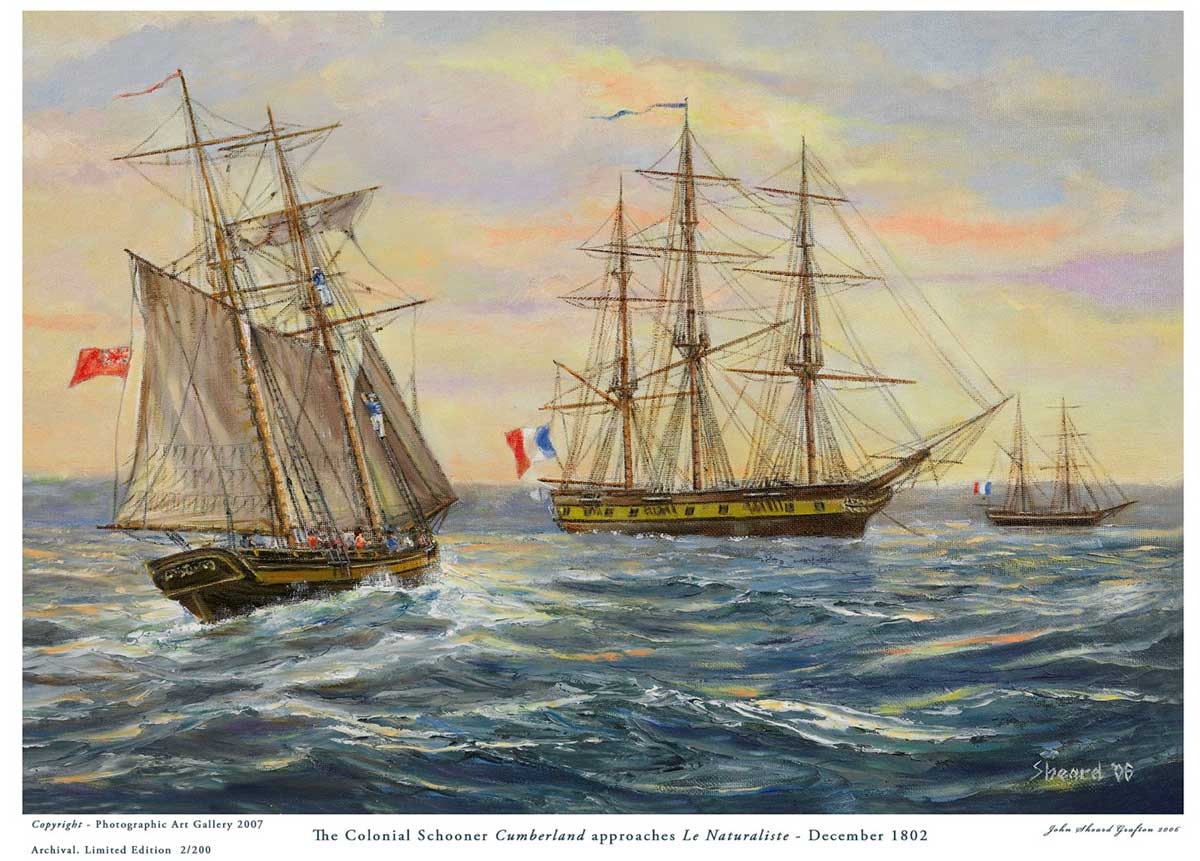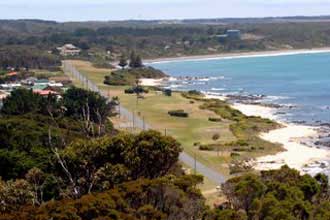In 1801, amid rumours that the French were sending a fleet of ship to New Holland to establish a colony, Governor King dispatched the acting chief surveyor of New South Wales, 19-year old Charles Grimes, to King’s Island, Port King (Port Phillip Bay as it was then known) and Storm Bay (the bay into which the Derwent River flows to the south of Hobart) to claim for Britain the southern section of the eastern side of the continent south of latitude 38 degrees S, and to investigate the possibility of setting up settlements to forestall any moves by the French to lay claim to sections of the continent of Australia already annexed by Britain. Other motives were to establish a base for the fishing and sealing industry and to provide timber and flax to the Royal Navy which had been depleted by the Napoleonic Wars.
They set sail from Sydney on 29 November 1801 in the Lady Nelson. They surveyed several islands in Bass Strait and spent some time on a larger one which had been named King Island after the Governor of New South Wales. On completion of the survey, Murray headed back to the mainland to explore Port Phillip, which was known but had not been entered or explored. After the entrance to the bay was found on 2 February, the Lady Nelson entered it and a survey of the bay was commenced. They went ashore at Point King, 2 km west of present-day Sorrento on Port Phillip Bay and claimed the land for Britain. Three days later they left the bay, returning to Sydney Cove on 24 March.
Six weeks after Murray returned from his trip to the Port Phillip Bay area, Governor King’s fears that the French has sent an expedition to check out the coast of New Holland were realised when Matthew Flinders, who had been charting the south coast of Australia, returned to Sydney with the news that he had met the French exploration party of Nicolas Baudin at Encounter Bay. Shortly after Flinders’ arrival, Baudin’s ships limped into port, his crew in a poor state of health and in desparate need of supplies.
Baudin spent his five month stay in Sydney on good terms with Governor King, however Lieut. Colonel Patterson had chatted over wine and dessert with French officers, who casually mentioned they might establish a base at Storm Bay. King’s response was swift.
In a letter dated 9 May 1803, to Sir Evan Nepean, Secretary of the Admiralty, King wrote; “It was reported to me after the French ships sailed that a principal object of their voyage was to fix on a place at Van Diemens Land for a settlement, and that the French officers who had talked of it had pointed out a particular place, what they called Baie du Nord (North West Bay) in Storm Bay Passage (D’Entrecasteaux Channel). “Under these circumstances I judged it expedient to form a settlement at Risdon Cove in the River Derwent”.
Charles Robbins (1782-1805), a young, passionate and abiding member of the English Admiralty, had recently arrived in the colony as midshipman aboard H.M.S. Buffalo when it made its maiden voyage out to New South Wales at the start of 1802.
Under private instructions from Governor King, Acting Lieutenant Robbins was hastily sent south from the Colony of Port Jackson (Sydney) with the schooner Cumberland and a party of 16 men to examine Bass Strait and to thwart any colonising attempts by the French. Officially, the purpose of the survey was to establish whether or not either location might prove a suitable site for a new settlement.
The Cumberland was the first sea-going vessel built in the Colony and the first armed vessel belonging to the Colony, being of 29 tons and a length of 40 feet; it was built in Sydney by Henry Moore, the government boat-builder, and launched in 1801.
The Cumberland’s party of 17 included commander Charles Robbins, Acting Surveyor-General Charles Grimes (1772-1858), Surveyor James Meehan (1774-1826), James Fleming (gardener), Mr. McCallum (doctor), and three marines from H.M.S. Buffalo. Meehan had been sentenced to transportation for a part in the Irish rebellion of 1798; he arrived in Sydney in February 1800 and in April of that year was assigned as an assistant to Charles Grimes.
Gov King wrote to Baudin that all Van Diemen’s Land and the south west coast of New South Wales were proclaimed part of the British Empire in 1788, and could not be occupied by the French without a breach of the friendly relations recently entered into between England and France. Robbins was given the despatch in secret and sent on his way.
On 13 December 1802, Robbins entered Sea Elephant Bay, King Island, to find Baudin’s ships at anchor off shore near the present site of Naracoopa. Panic struck, Robbins launched a long boat with a party of men and made a dash for the shore. Ribbins delivered the despatch to Baudin, pulled out a Union Jack and proceeded to claim Van Diemen’s Land for England. This was the first occasion the newly-created Union Jack was flown in Australia and Robbins made a shambles of it.
They set sail from Sydney on 29 November 1801 in the Lady Nelson. They surveyed several islands in Bass Strait and spent some time on a larger one which had been named King Island after the Governor of New South Wales. On completion of the survey, Murray headed back to the mainland to explore Port Phillip, which was known but had not been entered or explored. After the entrance to the bay was found on 2 February, the Lady Nelson entered it and a survey of the bay was commenced. They went ashore at Point King, 2 km west of present-day Sorrento on Port Phillip Bay and claimed the land for Britain. Three days later they left the bay, returning to Sydney Cove on 24 March.
Six weeks after Murray returned from his trip to the Port Phillip Bay area, Governor King’s fears that the French has sent an expedition to check out the coast of New Holland were realised when Matthew Flinders, who had been charting the south coast of Australia, returned to Sydney with the news that he had met the French exploration party of Nicolas Baudin at Encounter Bay. Shortly after Flinders’ arrival, Baudin’s ships limped into port, his crew in a poor state of health and in desparate need of supplies.
Baudin spent his five month stay in Sydney on good terms with Governor King, however Lieut. Colonel Patterson had chatted over wine and dessert with French officers, who casually mentioned they might establish a base at Storm Bay. King’s response was swift.
In a letter dated 9 May 1803, to Sir Evan Nepean, Secretary of the Admiralty, King wrote; “It was reported to me after the French ships sailed that a principal object of their voyage was to fix on a place at Van Diemens Land for a settlement, and that the French officers who had talked of it had pointed out a particular place, what they called Baie du Nord (North West Bay) in Storm Bay Passage (D’Entrecasteaux Channel). “Under these circumstances I judged it expedient to form a settlement at Risdon Cove in the River Derwent”.
Charles Robbins (1782-1805), a young, passionate and abiding member of the English Admiralty, had recently arrived in the colony as midshipman aboard H.M.S. Buffalo when it made its maiden voyage out to New South Wales at the start of 1802.
Under private instructions from Governor King, Acting Lieutenant Robbins was hastily sent south from the Colony of Port Jackson (Sydney) with the schooner Cumberland and a party of 16 men to examine Bass Strait and to thwart any colonising attempts by the French. Officially, the purpose of the survey was to establish whether or not either location might prove a suitable site for a new settlement.
The Cumberland was the first sea-going vessel built in the Colony and the first armed vessel belonging to the Colony, being of 29 tons and a length of 40 feet; it was built in Sydney by Henry Moore, the government boat-builder, and launched in 1801.
The Cumberland’s party of 17 included commander Charles Robbins, Acting Surveyor-General Charles Grimes (1772-1858), Surveyor James Meehan (1774-1826), James Fleming (gardener), Mr. McCallum (doctor), and three marines from H.M.S. Buffalo. Meehan had been sentenced to transportation for a part in the Irish rebellion of 1798; he arrived in Sydney in February 1800 and in April of that year was assigned as an assistant to Charles Grimes.
Gov King wrote to Baudin that all Van Diemen’s Land and the south west coast of New South Wales were proclaimed part of the British Empire in 1788, and could not be occupied by the French without a breach of the friendly relations recently entered into between England and France. Robbins was given the despatch in secret and sent on his way.
On 13 December 1802, Robbins entered Sea Elephant Bay, King Island, to find Baudin’s ships at anchor off shore near the present site of Naracoopa. Panic struck, Robbins launched a long boat with a party of men and made a dash for the shore. Ribbins delivered the despatch to Baudin, pulled out a Union Jack and proceeded to claim Van Diemen’s Land for England. This was the first occasion the newly-created Union Jack was flown in Australia and Robbins made a shambles of it.











